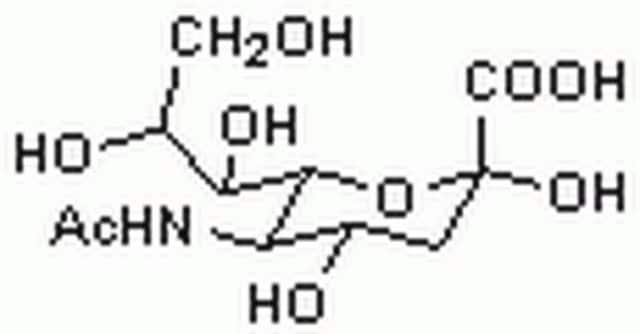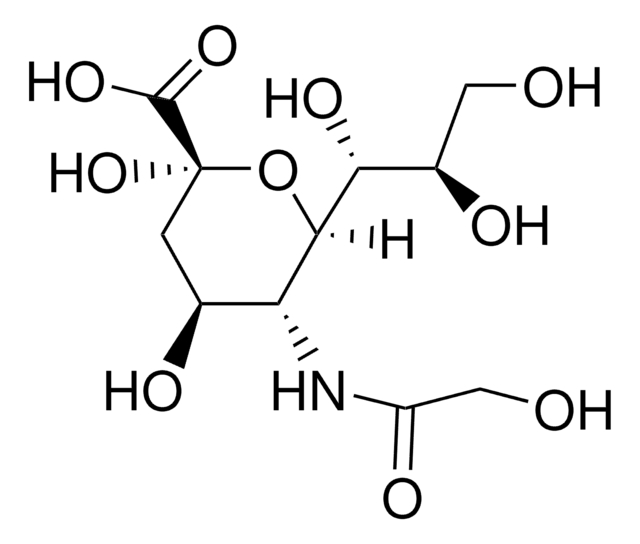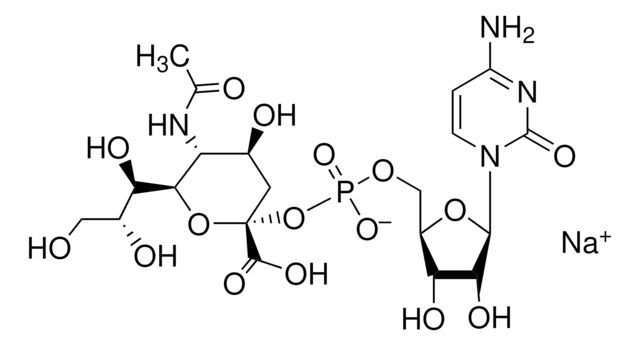The hydrolysis reagent in this kit is Sulfuric acid.
MAK314
Sialic Acid Assay Kit
sufficient for 100 colorimetric or fluorometric tests
Synonym(s):
Sialic Acid (NANA) Assay Kit
About This Item
Recommended Products
usage
sufficient for 100 colorimetric or fluorometric tests
detection method
colorimetric
fluorometric
relevant disease(s)
cancer; cardiovascular diseases; hematological disorder
storage temp.
−20°C
Related Categories
General description
Application
- Evaluation of serum total sialic acid in moderate COVID-19 patients with and without gastrointestinal tract manifestations.: The study measures serum sialic acid levels in COVID-19 patients to understand the disease′s impact on the gastrointestinal tract (Haroun et al., 2022).
Suitability
Principle
Signal Word
Danger
Hazard Statements
Precautionary Statements
Hazard Classifications
Aquatic Chronic 2 - Eye Dam. 1 - Met. Corr. 1 - Skin Corr. 1A - STOT SE 3
Target Organs
Respiratory system
Storage Class Code
8A - Combustible corrosive hazardous materials
Flash Point(F)
Not applicable
Flash Point(C)
Not applicable
Choose from one of the most recent versions:
Certificates of Analysis (COA)
Don't see the Right Version?
If you require a particular version, you can look up a specific certificate by the Lot or Batch number.
Already Own This Product?
Find documentation for the products that you have recently purchased in the Document Library.
Customers Also Viewed
-
What is the hydrolysis reagent in this kit?
1 answer-
Helpful?
-
-
1. Can we use this assay for urine samples? 2. How long can prepared standard samples be stored in a -20 freezer, and should we add 10% TCA before freezing? 3. Temperature for centrifuging was not specified. Does it mean room temperature?
1 answer-
This assay has not been validated with urine, but there is no known reason why it wouldn’t work. Standards should be prepared fresh for each run. Do not prepare the standard and freeze it for future use because the stability of the dilute standard when undergoing freeze/thaw cycles has not been tested. In the case of urine samples, it would be best to use fresh samples when possible. If it’s necessary to freeze samples, freeze them for only 2-3 days at -80°C. Regarding the addition of TCA, it would likely be best to freeze whole samples and then hydrolyze upon thawing. However, there is no reason why customers couldn’t prepare the “TSA” and “FSA” samples, as described in the protocol, and then freeze the supernatant. Finally, all centrifuge steps can be carried out at room temperature.
Helpful?
-
-
When we measure total sialic acid, does it include free sialic acid? Or does it only measure the bound sialic acid that is released?
1 answer-
This kit measures total sialic acid (TSA). The results account for sialic acid that was bound and hydrolyzed, as well as free sialic acid.
Helpful?
-
-
What are the recommended procedures for sample preparation and storage prior to using the Sialic Acid Assay Kit, product code MAK314, particularly for cell culture and tissue samples? Should cell pellets and tissues be homogenized in PBS or another type of buffer for the assay?
1 answer-
The standard protocol for preparing cell and tissue samples as follows:
**Tissue Samples:**
- Begin with 20-100 mg of tissue.
- Add 200-1000 μL of ice-cold PBS.
- Achieve lysis by either homogenizing with 10-20 passes in a Dounce homogenizer on ice or by sonication, preferably in an ice-water bath.
- Check the degree of lysis under a microscope.
- Centrifuge the homogenate at 14,000 g for 10 minutes.
- Transfer the clear supernatant to a clean tube.
- Conduct a pilot test at various dilutions to find an appropriate dilution that fits within the standard curve's detection range for further assays.
- Store most samples at -80°C if not assayed immediately.**Cell Samples:**
- Suspend approximately two million harvested cells in 400 μL of PBS on ice.
- Lysis can be achieved similarly to tissue samples, through homogenization or sonication.
- Verify cell lysis under a microscope.
- Centrifuge the homogenate at 14,000 g for 10 minutes.
- Transfer the clear supernatant to a clean tube.
- Perform a pilot test at different dilutions to select a suitable one within the linear range of the standard curve for further assays.
- Samples can generally be stored at -80°C if not immediately assayed.If a lysis buffer is to be used, an assay should be conducted first to check whether the components of the lysis buffer interfere with the assay. This involves running two standard curves: one in H2O (or buffer) and one in the same proportion of lysis buffer that the sample will contain. If both curves match, the lysis buffer does not interfere. If there is a discrepancy, the lysis buffer may still be utilized if the standard curve is linear, but the standard curve for analyzing lysate samples will then need to be prepared in the lysis buffer.
Helpful?
-
-
Should the first centrifugation, which occurs after heating at 80°C for 60 minutes and cooling, also be at 14,000 rpm for 10 minutes as mentioned in the protocol?
1 answer-
The first centrifugation, after cooling and before adding 25 uL of the 10% TCA, can be a quicker spin at 14,000 rpm for 3-5 minutes. After adding the TCA, a second centrifugation at 14,000 rpm for 10 minutes is recommended.
Helpful?
-
-
What are the minimum and maximum concentrations of sialic acid the assay is able to measure? Both for the colorimetric and fluorometric methods.
1 answer-
The linear detection range of the kit is 5 to 1000 µM sialic acid for colorimetric assays and 0.5 to 100 µM for fluorometric assays. Please see the link below to review the product datasheet:
https://www.sigmaaldrich.com/deepweb/assets/sigmaaldrich/product/documents/185/226/mak314bul.pdfHelpful?
-
Active Filters
Our team of scientists has experience in all areas of research including Life Science, Material Science, Chemical Synthesis, Chromatography, Analytical and many others.
Contact Technical Service














